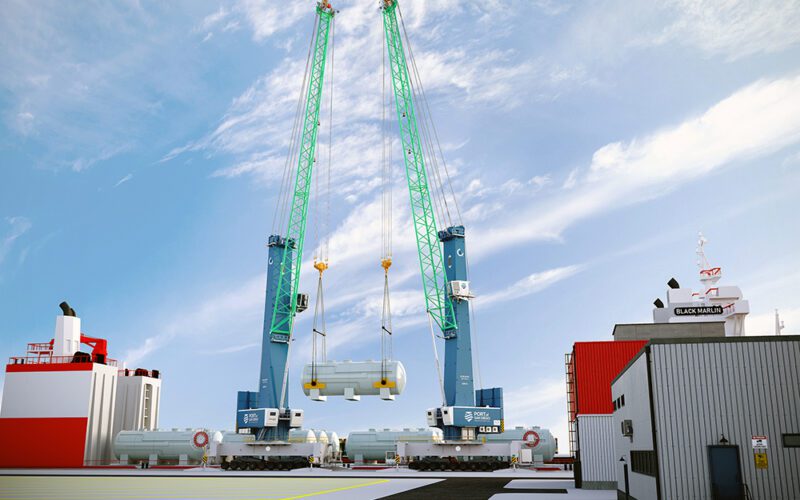
The global container handling equipment (CHE) market is estimated to reach $10.16 billion by 2030, according to Straits Research. The drive to cut emissions, improve efficiencies and keep people safe are some of the top trends that are influencing the market’s effect on ports around the world.
The U.S. is forecast to see significant growth with its abundant electric vehicle infrastructure facilities, coupled with government support. While going all-electric is the predominant trend, a variety of new technologies are coming online for CHE uses.
The ports of Los Angeles and Long Beach, as part of their San Pedro Bay Ports Clean Air Action Plan (CAAP), are transitioning terminal equipment to zero emissions by 2030. The CAAP 2021 study revealed that the majority of CHE original equipment manufacturers working with San Pedro Bay Ports and Marine Terminal Operations are focused on zero emissions and/or near-zero emissions (NZE) fuel-technology platforms, among others.
The ports are currently demonstrating 91 pieces of terminal equipment, including zero-emissions yard tractors, top handlers, forklifts, rubber-tired gantry cranes (RTG) and Class 8 on-road trucks, including hybrid, battery-electric and hydrogen fuel cell technologies, with additional terminal equipment and on-road trucks to be commissioned by the end of the year.
In late 2022, the Port of Long Beach received a $30.1 million grant from the U.S. Department of Transportation to replace diesel yard tractors with 60 electric, human-operated yard tractors at Long Beach Container Terminal, along with construction of electric-equipment charging stations.

Last September, the Port of San Diego received a $2.7 million grant from the San Diego County Air Pollution Control District to enable electrical upgrades to power two new all-electric mobile harbor cranes, touted to be the first mobile harbor cranes in North America.
Each crane has had its lift capacity increased from 100 metric tons (MT) to 400 MT. The conversion from diesel to electric is in keeping with the port’s drive for 100 percent zero-emission cargo handling equipment by 2030, under its Maritime Clean Air Strategy.
The new cranes are expected to be in operation at the port’s Tenth Avenue Marine Terminal by this summer.
Recently, the Oakland Board of Port Commissioners approved an environmental ordinance that included requiring tenants that operate cargo-handling equipment to create a plan by the end of the year for converting CHE to ZE as part of the Port of Oakland’s Seaport Air Quality 2020 and Beyond Plan.
Three years ago, the port achieved a 95% reduction of diesel emissions from its operations when it converted 13 diesel RTG cranes to hybrid using battery packs.



“That’s a real success story,” Tracy Fidell, an associate environmental planner/scientist with the port, said. “You can keep the same frame of the RTG and swap out the big diesel engine for a much smaller one and a battery pack that does all the work of the RTG. It saves on the fuel costs for the owner as well, a real win-win for the community and for business.”
Currently, the port is demonstrating two electric top-picks and 10 electric on-road truck feasibility projects (Zero and Near Zero Emissions Freight Facilities—ZANZEFF grant program), and by mid-year is expected to receive 30 hydrogen fuel cell on-road trucks. There are seven more electric drayage trucks in use at the Port of Oakland which are operating through other grant programs.
Additionally, the port is installing two mobile shore power outlets on a track mounted on the face of the wharf behind the fenders at Oakland International Container Terminal. These would be among the first of their kind in the U.S., according to the seaport.
In British Columbia, the Vancouver Fraser Port Authority and its partners are also testing various low- and zero-emission fuels and technologies at the Port of Vancouver as part of the overall mission to achieve NZE by 2050.
The port authority and the Province of BC are said to be investing about $1.5 million in these efforts, including testing battery-electric powered terminal tractors. Recently, five ZE rail-mounted gantry (RMG) cranes were installed at the Centerm terminal.
Retrofitting a hydrogen fuel cell powered RTG is also in the final planning stages as part of terminal operator DP World’s goal to reduce CO2 emissions by about 700,000 tons with an investment of nearly $500 million over the next five years.
Kathy A. Smith writes for global maritime trade journals and provides marketing copy to maritime businesses worldwide. She can be reached at maritimewriter@gmail.com.

